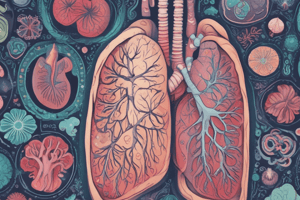Podcast
Questions and Answers
Which adrenergic receptor subtype is responsible for inhibiting norepinephrine release?
Which adrenergic receptor subtype is responsible for inhibiting norepinephrine release?
- Beta-2
- Beta-1
- Alpha-1
- Alpha-2 (correct)
Which beta-adrenergic receptor subtype is primarily responsible for bronchodilation?
Which beta-adrenergic receptor subtype is primarily responsible for bronchodilation?
- Alpha-1
- Beta-2 (correct)
- Beta-3
- Beta-1
In terms of receptor specificity, which drug has a higher affinity for alpha-2 adrenergic receptors compared to alpha-1 receptors?
In terms of receptor specificity, which drug has a higher affinity for alpha-2 adrenergic receptors compared to alpha-1 receptors?
- Phenylephrine
- Clonidine (correct)
- Methoxamine
- Norepinephrine
Which of the following drugs has mixed alpha and beta agonistic activity?
Which of the following drugs has mixed alpha and beta agonistic activity?
Which adrenergic receptor subtype is primarily responsible for increasing glycogenolysis?
Which adrenergic receptor subtype is primarily responsible for increasing glycogenolysis?
Which drug is selective for beta-2 adrenergic receptors and is used to treat asthma?
Which drug is selective for beta-2 adrenergic receptors and is used to treat asthma?
Which type of agonist has a high affinity for beta 2 receptors and a duration of action of more than 12 hours?
Which type of agonist has a high affinity for beta 2 receptors and a duration of action of more than 12 hours?
Which characteristic is true about formoterol?
Which characteristic is true about formoterol?
Which condition are formoterol and salmeterol agents of choice for?
Which condition are formoterol and salmeterol agents of choice for?
What is the primary therapeutic use of ritodrine?
What is the primary therapeutic use of ritodrine?
Which adverse effect is commonly associated with beta 2-selective agonists?
Which adverse effect is commonly associated with beta 2-selective agonists?
Which substance is found in cheese, beef, wine, and can be transported into nerve terminals due to its resemblance to norepinephrine (NE)?
Which substance is found in cheese, beef, wine, and can be transported into nerve terminals due to its resemblance to norepinephrine (NE)?
Beta blockers like propranolol inhibit which of the following in the pulmonary system?
Beta blockers like propranolol inhibit which of the following in the pulmonary system?
What is the preferred type of beta blocker to avoid delays in recovery from hypoglycemia?
What is the preferred type of beta blocker to avoid delays in recovery from hypoglycemia?
Which therapeutic use is NOT associated with beta blockers as mentioned in the text?
Which therapeutic use is NOT associated with beta blockers as mentioned in the text?
Which metabolic effect is associated with beta blockers?
Which metabolic effect is associated with beta blockers?
In addition to cardiac diseases, what other therapeutic use is mentioned for beta blockers in the text?
In addition to cardiac diseases, what other therapeutic use is mentioned for beta blockers in the text?
Which effect on the cardiovascular system is not listed as a therapeutic use of beta blockers?
Which effect on the cardiovascular system is not listed as a therapeutic use of beta blockers?
Study Notes
- Ipratropium and Tiotropium are used as inhalational drugs in the treatment of asthma and COPD.
- Adverse effects of these drugs include constipation, dry mouth, decreased sweating, dilated pupils, urinary retention, precipitation of glaucoma, decreased lacrimation, and tachycardia.
- Cooling agents and seizure control medications (diazepam) are used in the treatment of toxicity from these drugs.
- Contraindications to the use of anticholinergics include BPH, myasthenia gravis, glaucoma, and tachydysrhythmias.
- Reading assignment topics include ganglionic blockers, neuromuscular blockers, and the pharmacology of the adrenergic nervous system.
- Adrenergic receptors include α1, α2, β1, β2, and β3, with different locations and effects on smooth muscles, heart, and lipocytes.
- Adrenergic agonists exhibit different degrees of selectivity for specific receptor subtypes.
- Long-acting β2-selective agonists, such as formoterol and salmeterol, are used in the treatment of asthma and COPD.
- β2-Selective agonists, such as ritodrine, have adverse effects including tremor, restlessness, anxiety, tachycardia, and increased bronchial hypersensitivity.
- Indirect-acting sympathomimetic drugs, such as ephedrine and amphetamine, are taken up into nerve terminals and displace norepinephrine, leading to various pharmacological effects.
- Non-selective β-receptor antagonists inhibit bronchial smooth muscle relaxation, while decreasing aqueous humor production in the eye and interfering with counter-regulatory metabolic effects.
- β1-selective antagonists are preferred in the treatment of hypoglycemia, as they are less likely to delay recovery.
- Cardiovascular diseases, including angina pectoris, myocardial infarction, dysrhythmias, heart failure, and hypertension, are treated with β-blockers.
- β-blockers are also used in the treatment of chronic open-angle glaucoma and as an adjunct to definitive treatment for thyrotoxicosis.
Studying That Suits You
Use AI to generate personalized quizzes and flashcards to suit your learning preferences.
Description
Learn about the use of Ipratropium and Tiotropium as inhalational drugs in asthma and COPD, along with their adverse effects and toxicity treatment. Understand contraindications to anticholinergic medications.




